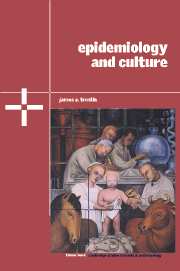Book contents
- Frontmatter
- Contents
- List of Figures and Tables
- Foreword by S. Leonard Syme
- Acknowledgments
- Epidemiology and Culture
- 1 Introduction
- 2 The Origins of an Integrated Approach in Anthropology and Epidemiology
- 3 Disease Patterns and Assumptions: Unpacking Variables
- 4 Cultural Issues in Measurement and Bias
- 5 Anthropological Contributions to the Study of Cholera
- 6 Anthropological and Epidemiological Collaboration to Help Communities Become Healthier
- 7 Perceiving and Representing Risk
- 8 Conclusion
- References
- Index
- References
3 - Disease Patterns and Assumptions: Unpacking Variables
Published online by Cambridge University Press: 05 June 2012
- Frontmatter
- Contents
- List of Figures and Tables
- Foreword by S. Leonard Syme
- Acknowledgments
- Epidemiology and Culture
- 1 Introduction
- 2 The Origins of an Integrated Approach in Anthropology and Epidemiology
- 3 Disease Patterns and Assumptions: Unpacking Variables
- 4 Cultural Issues in Measurement and Bias
- 5 Anthropological Contributions to the Study of Cholera
- 6 Anthropological and Epidemiological Collaboration to Help Communities Become Healthier
- 7 Perceiving and Representing Risk
- 8 Conclusion
- References
- Index
- References
Summary
Dr. Donald M. Berwick, a Boston pediatrician, said recently, “Tell me someone's race. Tell me their income. And tell me whether they smoke. The answers to those three questions will tell me more about their longevity and health status than any other questions I could possibly ask.”
(Kilborn 1998:A16)Dime cómo mueres y te diré quién eres.
(Tell me how you die and I will tell you who you are.)
(Paz 1993:59)A pediatrician predicts health status and lifespan from aspects of North American social status and identity; a writer divines identity from manner of death. These opposite positions are actually based on the same premise: that selfhood and mortality are intertwined. Both claims rest on the assumption that there are systematic connections between how people live and how they die.
Of course, any pattern of relationships between causes and outcomes is based on an underlying set of assumptions, because assumptions drive the choice of measures that allow the pattern to become visible. The choice of what variables to measure both directs and confines attention. As one researcher put it, “We will consistently fail to observe what we do not seek to find” (Burrage 1987). This chapter explores how different health-related disciplines define and employ a few key concepts: person, place, and time.
- Type
- Chapter
- Information
- Epidemiology and Culture , pp. 42 - 73Publisher: Cambridge University PressPrint publication year: 2005



